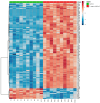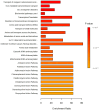A Comprehensive Multi-Omics Study of Serum Alterations in Red Deer Infected by the Liver Fluke Fascioloides magna
- PMID: 39599475
- PMCID: PMC11597349
- DOI: 10.3390/pathogens13110922
A Comprehensive Multi-Omics Study of Serum Alterations in Red Deer Infected by the Liver Fluke Fascioloides magna
Abstract
Liver fluke infections are acknowledged as diseases with global prevalence and significant implications for both veterinary and public health. The large American liver fluke, Fascioloides magna, is a significant non-native parasite introduced to Europe, threatening the survival of local wildlife populations. The aim of this study was to analyze differences in the serum proteome and metabolome between F. magna-infected and control red deer. Serum samples from red deer were collected immediately following regular hunting operations, including 10 samples with confirmed F. magna infection and 10 samples from healthy red deer. A proteomics analysis of the serum samples was performed using a tandem mass tag (TMT)-based quantitative approach, and a metabolomics analysis of the serum was performed using an untargeted mass spectrometry-based metabolomics approach. A knowledge-driven approach was applied to integrate omics data. Our findings demonstrated that infection with liver fluke was associated with changes in amino acid metabolism, energy metabolism, lipid metabolism, inflammatory host response, and related biochemical pathways. This study offers a comprehensive overview of the serum proteome and metabolome in response to F. magna infection in red deer, unveiling new potential targets for future research. The identification of proteins, metabolites, and related biological pathways enhances our understanding of host-parasite interactions and may improve current tools for more effective liver fluke control.
Keywords: host–pathogen interaction; liver fluke; metabolomics; proteomics; wildlife.
Conflict of interest statement
The authors declare no conflicts of interest. The funders had no role in the design of the study; in the collection, analyses, or interpretation of data; in the writing of the manuscript; or in the decision to publish the results.
Figures










Similar articles
-
Liver Proteome Alterations in Red Deer (Cervus elaphus) Infected by the Giant Liver Fluke Fascioloides magna.Pathogens. 2022 Dec 8;11(12):1503. doi: 10.3390/pathogens11121503. Pathogens. 2022. PMID: 36558836 Free PMC article.
-
Complementary liver and serum protein profile in wild boars infected by the giant liver fluke Fascioloides magna using tandem mass tags quantitative approach.J Proteomics. 2021 Sep 15;247:104332. doi: 10.1016/j.jprot.2021.104332. Epub 2021 Jul 20. J Proteomics. 2021. PMID: 34298188
-
The giant liver fluke Fascioloides magna (Bassi 1875) in cervids in the Czech Republic and potential of its spreading to Germany.Parasitol Res. 2007 Feb;100(3):549-53. doi: 10.1007/s00436-006-0299-4. Epub 2006 Oct 3. Parasitol Res. 2007. PMID: 17016724
-
[Bionomy, occurrence and importance of the giant liver fluke (Fascioloides magna), an important parasite of free-living ruminants].Vet Med (Praha). 1997 May;42(5):139-48. Vet Med (Praha). 1997. PMID: 9265369 Review. Czech.
-
The giant liver fluke in Europe: A review of Fascioloides magna within cervids and livestock with considerations on an expanding snail-fluke transmission risk.Adv Parasitol. 2023;119:223-257. doi: 10.1016/bs.apar.2022.10.002. Epub 2022 Dec 5. Adv Parasitol. 2023. PMID: 36707174 Review.
References
-
- Scheele B.C., Legge S., Blanchard W., Garnett S., Geyle H., Gillespie G., Harrison P., Lindenmayer D., Lintermans M., Robinson N. Continental-scale assessment reveals inadequate monitoring for threatened vertebrates in a megadiverse country. Biol. Conserv. 2019;235:273–278. doi: 10.1016/j.biocon.2019.04.023. - DOI
-
- Králová-Hromadová I., Juhásová Ľ., Bazsalovicsová E. The Giant Liver Fluke, Fascioloides magna: Past, Present and Future Research. Springer International Publishing; Berlin/Heidelberg, Germany: 2016. p. 106.
MeSH terms
Substances
LinkOut - more resources
Full Text Sources

